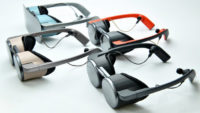CES 2020: Panasonic Reveals HDR-Capable VR Glasses
January 10, 2020
Panasonic demonstrated its prototype of a stylish, steampunk-looking set of VR goggles at CES this week. The company claims these are the first such ultra-high definition VR eyeglasses to offer support for HDR video content. The company envisions a number of applications for the glasses, including new VR experiences such as sports viewing and virtual travel experiences. Panasonic and its partner on the goggles, Massachusetts-based Kopin Corporation, expect to offer a commercial version featuring a compact and lightweight body sometime next year in anticipation of the many applications that will be enabled by 5G services.
According to the press release, “Panasonic’s audio and visual technologies have been incorporated into this new device, including signal processing technologies cultivated through the development of video equipment such as TVs and Blu-ray Disc players, acoustic technologies of Technics audio products, and optical technologies used in Lumix digital cameras.”

A reviewer for Engadget was impressed by the demos involving “high-res video of a beach captured from a drone” and “a CG recreation of a temple in Japan, including areas where visitors aren’t allowed to go.”
“The high quality of the scans used to create the temple combined with the goggles to make one of the more real-feeling virtual experiences I’ve ever had,” he wrote. “That came despite the glasses’ small micro OLED viewing windows.” And another upside for users with vision issues: “It was also a very comfortable experience thanks to swappable prescription lenses.”
Another reviewer cited several limitations that would likely be corrected prior to a commercial product. “The micro OLED panels were smaller than they could have been, resulting in a squarer image with a lower viewing angle than traditional VR headsets,” he wrote for The Verge. “The glasses were also a little front-heavy and slid down my nose whenever I tilted forward.”
“A non-functioning mockup of the envisaged final product, which I also got to wear, solved these problems by being significantly lighter and running a single USB-C cable through the end of one of the glasses’ arms.”
A reviewer writing for Upload VR noted a number of pros and cons, but ultimately asked: “Even if these glasses added some cameras and somehow became compatible with, say, Oculus Touch controllers and Oculus Quest apps — could you really play active games like ‘Beat Saber’ and keep a pair of sunglasses from flying off your head? Or if Panasonic sticks with 3DoF would these glasses reach a low enough price and have enough software and content support they could actually appeal to a decent number of people who just want a private movie viewer?”
“I don’t know the answers to any of those questions from my short demo,” he explained, “but this slim design fit well enough I hope we get to find out.”
Most reviewers so far seem to agree that there are some limitations to the prototype that require fine-tuning, but the form factor, design and comfort are compelling. And as The Verge reviewer concluded, Panasonic’s glasses are “an intriguing look at a step that could make VR technology more appealing to a mainstream audience.”

No Comments Yet
You can be the first to comment!
Sorry, comments for this entry are closed at this time.